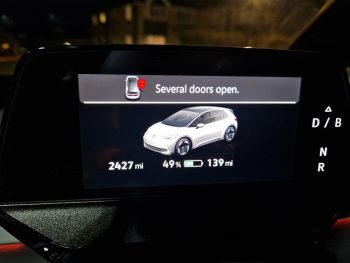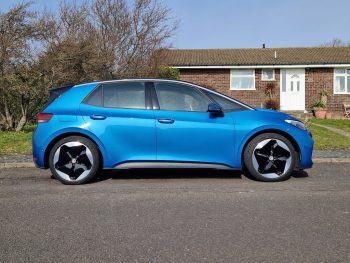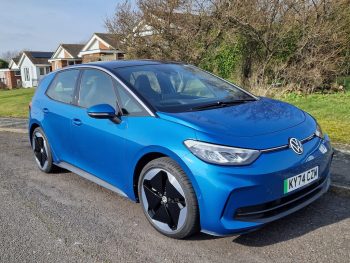Fleet World Fleet: Volkswagen ID.3
John Challen reports back on our Volkswagen ID.3 long-termer.
Volkswagen ID.3 Pro S 77kWh
OTR PRICE £43,275 | BiK 3% | RANGE 346 miles | ON FLEET RANGE 330 miles | EFFICIENCY 3.5mpkWh
Report 3:
 A few sedate long journeys and a bit more sunshine and heat in the air has boosted the ID.3’s economy up to 3.5mpkWh in recent weeks, which is encouraging. I must admit, I was a bit alarmed at the relatively low figure I was seeing on journeys, but at least I now know there isn’t anything wrong with the system. In fact, having kept a closer eye on the numbers since they started moving in the right direction, there were some decent efficiency totals noted, including 4.3mpkWh on a 164-mile round-trip to Reading and up to 7.7mpkWh for a much shorter (4.1 miles) jaunt along the road and back.
A few sedate long journeys and a bit more sunshine and heat in the air has boosted the ID.3’s economy up to 3.5mpkWh in recent weeks, which is encouraging. I must admit, I was a bit alarmed at the relatively low figure I was seeing on journeys, but at least I now know there isn’t anything wrong with the system. In fact, having kept a closer eye on the numbers since they started moving in the right direction, there were some decent efficiency totals noted, including 4.3mpkWh on a 164-mile round-trip to Reading and up to 7.7mpkWh for a much shorter (4.1 miles) jaunt along the road and back.
Meanwhile, the same screen that is relaying the information about my driving performance has thrown up some other interesting thoughts. For one thing, it has amused me with various messages that pop up on entering and leaving the car, my favourite being ‘Several doors open’. I don’t know why it tickles me so much, I think it’s just the very particular wording of the information. Technically it is correct, but why not just go with ‘Doors open’, because it indicates which ones they are with a little graphic alongside?
Staying with the display, in a day and age where massive ones can dominate the driver’s area, it’s encouraging to see one that is compact (5.3-inch) by comparison. Not only that, but it has the ability to display a lot of information (speed, ADAS, battery SOC and efficiency and trip details) in a very clear and sensible way.
Report 2:

Some of the concerns people might have with cars such as the ID.3 is how they perform out of towns – which is probably seen as their natural habitat. But I’ve completed a few motorway runs up and down the country now and it’s a dream. There’s little cabin noise, save for a bit of grumble coming from the tyres, but that’s almost a given with pretty much every car these days. Especially the concrete section of the bottom of the M25, but we’ll save that rant for another day.
Equally, the ID.3 is more than at home in towns and cities. Easy to manoeuvre, helped by a tight turning circle and light steering – but still with a bit of feel. A few trips along the road to Brighton has seen the ID.3 come into its own with the ability to squeeze into small gaps and navigate roads where people have double-parked – standard for the Sussex city, to be honest.
Visibility is good, even without the front and rear cameras, which makes the job even easier!
First report:

As the smallest member of Volkswagen’s electric family, the arrival of the ID.3 Pro S left me fearing the worst with five of us, including three growing Challen Jnrs.
In reality, I – and my passengers – have been seriously impressed with the relatively cavernous interior of the ID.3 as well as the quality and switchgear, which has undergone a bit of an upgrade since the original model. The main criticisms were that things had been stripped too far back and the controls were difficult to operate. Now, having taken a leaf out of the ID.7’s layout, elements such as volume and mirrors are much easier to adjust.
It’s often an overused phrase, but our ID.3 is probably close to fully loaded. As well as the standard kit there’s adaptive chassis control (£955), assistance plus (£2,240) and interior plus (£3,865) packs, carpet mats (£105), panoramic glass roof (795), variable luggage floor (£75) and a transport hitch for a bicycle carrier (£365). Add in the £810 colour scheme and this particular model comes in at £52,485 – quite the premium over list.
Out on the road, first impressions are positive, although the claimed economy of 4.2mpkWh doesn’t seem to be in reach right now. but most of the journeys in the ID.3 have been in and around town, which might explain that. With a few longer runs coming up, I’m hoping that the needle will shift a bit there soon.
















Leave a comment